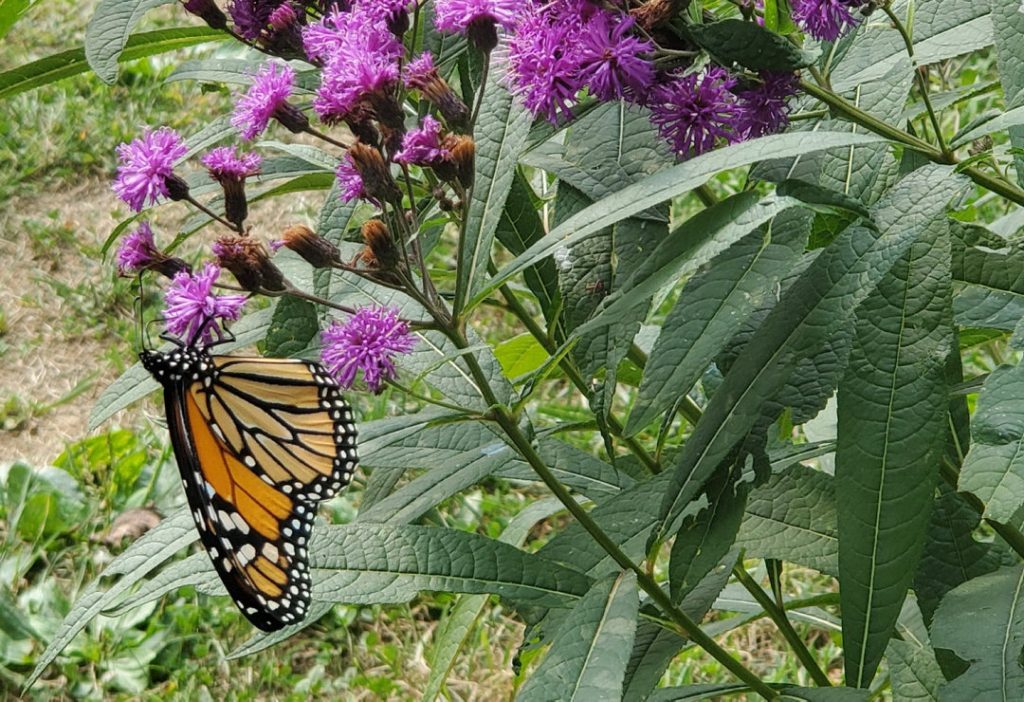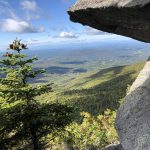BY LEAH ZERBE
The green chrysalis patiently hanging underneath an old farm picnic table started turning translucent.
Any moment now, the bright monarch inside would emerge, dry its wings and start seeking out nectar — its lifeline and key to surviving the long and dangerous migration from Pine Grove to the oyamel fir forests of Mexico.
The swamp milkweed plant that fueled its transition from monarch caterpillar to butterfly stood bare and leafless just 4 feet away.
Now, with a newly emerged butterfly on its way, other plants will need to pick up the slack.
Are they growing in your neighborhood?
Creating the nectar trail
Late-summer monarchs are currently on the move, pushing south toward their overwintering grounds. In addition to hurricanes, flooding, drought, abnormally high temperatures and wildfires intensified by man-made fossil fuel pollution, these monarchs face another threat along the way: starvation.
Cornell researchers found monarchs actually face their greatest food shortage during the fall migration.
Going beyond milkweed
While it is absolutely critical to plant swamp milkweed (Asclepias incarnata), common milkweed (Asclepias syriaca) and butterfly weed (Asclepias tuberosa) in Pennsylvania to provide “supper” for hungry monarch caterpillars, ending your monarch gardening efforts there falls short of supporting the butterfly’s full life cycle and journey.
This last generation of 2020 butterflies — the migrators — rely on late-season nectar sources from here to Mexico to build up fat stores and fuel their epic flight. If they can’t find late-summer and fall nectar sources, they simply won’t make it. And that’s on us.
Creating a “nectar trail” is one important thing we should do to help monarch butterflies build strength and resiliency as they pass through Schuylkill County.
Let’s inundate our community parks, business and school landscapes, farm field borders, street planters and yards with the crucial nectar today’s monarchs need to fuel up.
Top native plant nectar picks for migrating monarchs
Goldenrod. First and foremost, goldenrod isn’t causing your fall allergies. That’s ragweed. Both plants boast yellow late-season blooms, but goldenrod’s large, sticky pollen doesn’t travel by wind, so it won’t trigger sniffles and watery eyes like ragweed does. And when it comes to ragweed, you’ve got lots of options to work with, making it easy to find the best goldenrod for your situation:
- Canada goldenrod (Solidago canadensis)
- Blue Stemmed Goldenrod (Solidago caesia)
- Zigzag Goldenrod (Solidago flexicaulis)
- Rough-Stemmed Goldenrod (Solidago rugosa)
- Grass-leaved goldenrod (Solidago graminifolia)
- Showy Goldenrod (Solidago speciosa)
Asters. Like goldenrod, native asters are one of the most important fall nectar sources for monarch butterflies. In fact, these blooms often outlast goldenrod.
- New York Aster (Symphyotrichum novi-belgii)
- New England Aster (Symphyotrichum novi-angliae)
- Smooth blue aster (Symphyotrichum laeve var. laeve)
New York Ironweed (Vernonia fasciculata). Tall with intense purple blooms, this easy-to-grow plant prefers rich, moist, well-drained soils, although it tolerates a wide range of soils.
Narrow-Leaved Sunflower (Helianthus angustifolius). Growing 3 to 8 feet tall, this plant prefers wet to moist soil conditions in sun to partial shade. A great option for wetter parts of the yard.
Narrow-Leaved Mountain Mint (Pycnanthemum tenuifolium). A perfect late summer nectar source that thrives in sun to part shade and in dry to moist well-drained soils.
Contact the writer: leah.zerbe@gmail.com



